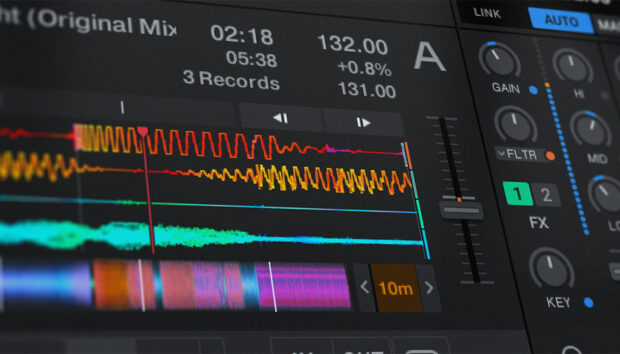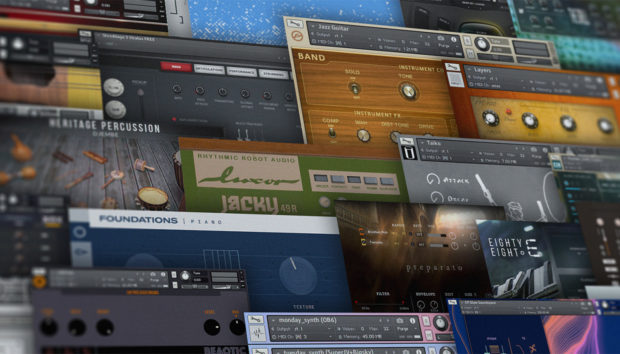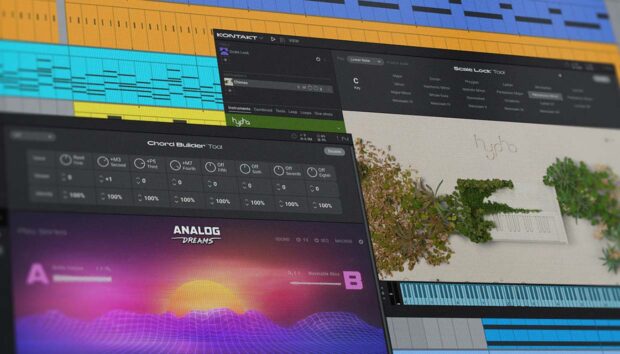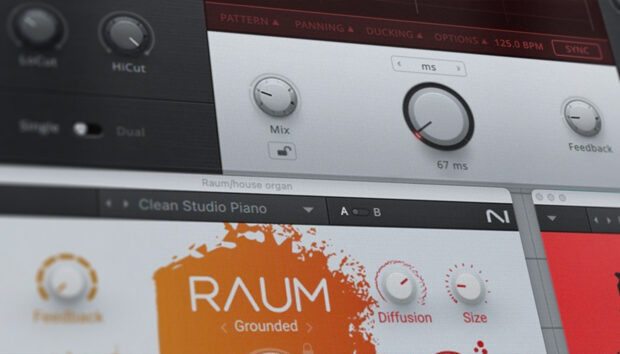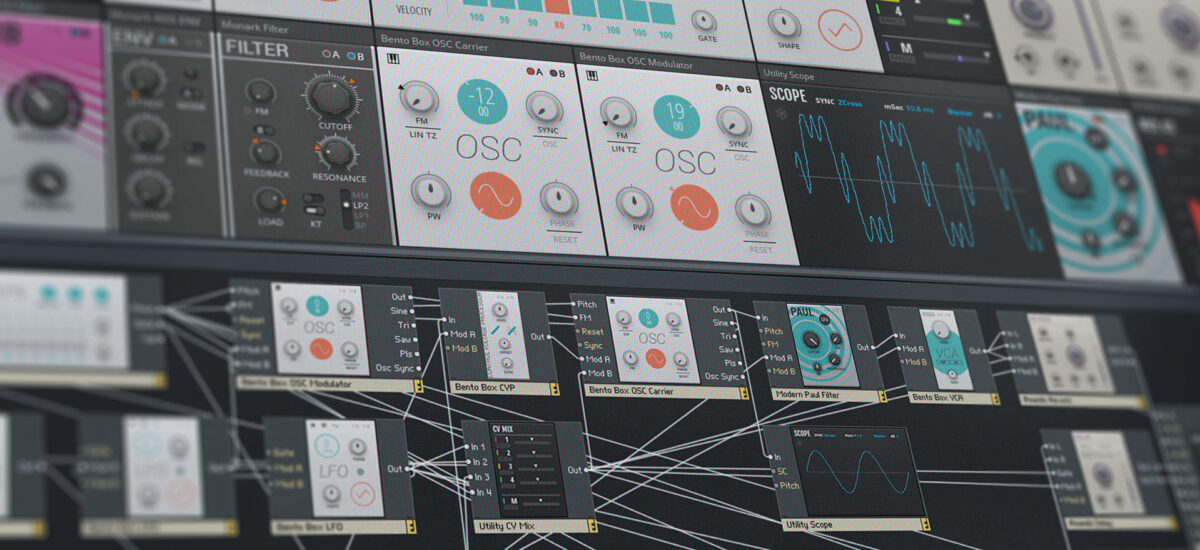
Modular synthesis is one of the most intimidating topics in music production. Those in the know love modular synths, praising them for their versatility and creative potential. But outsiders sometimes struggle to understand what the fuss is about. What is modular synthesis exactly? What makes modular synths special and how do they work? And how can you overcome the steep learning curve to get a solid grip on this unique synthesis method?
This comprehensive guide will answer all of these questions and more. We’ll cover the basic principles of modular synthesis, explain how to build a modular synth, and share inspiring examples of modular synths in action. Read on if you’re keen to learn modular synthesis. Your journey towards the rig of your dreams is about to begin – just take it one module at a time.
Jump to these sections:
- What is a modular synthesizer?
- What does a modular synthesizer do?
- What is modular synthesis used for?
- Is modular synthesis hard?
- Is modular synthesis expensive?
- Essential components and setup
- What do you need to start modular synthesis?
- Understanding signal types: Audio and CV
- Building a modular synthesizer
- Do your research
- Have a goal
- Start small
- Get these basic modules
- Uses and applications of modular synthesis in music
- Give familiar genres a fresh twist
- Generate new patterns and forms
- Make music tactile
- Create wild new sounds
- Expanding your system: from beginner to advanced
- Explore sound generators
- Go deep with sequencing
- Try weird effects
- Conclusion: Start your modular synth journey
Follow along with this tutorial using Reaktor Blocks.
What is a modular synthesizer?
A modular synthesizer is a synthesizer made out of standalone components, or modules, that work together to create sound. These modules are connected by patch cables in a configuration chosen by the user. By using different modules, and patching them together differently, you can create a huge variety of different sounds using modular synthesis.
In fact, you could argue that all synthesizers consist of distinct modules that perform various functions. But in most synths, the selection and configuration of these modules is fixed by the company that made the synth. Sure, some might give you an aspect of modularity. For example, the popular soft synth Massive X allows you to assign modulators to a wide range of parameters within the synth, and the way you make these connections can change the way the synth behaves. But in conventional synths, there are limits to how far you can customize your sound.
Modular synths offer complete freedom. You can build one out of any of the hundreds of modules on the market – from traditional synth components like oscillators, envelopes, and filters, to powerful sequencers and unique audio effects. And these modules can be patched together in virtually any configuration, limited only by your imagination and expertise. This makes modular synthesis a dream come true for adventurous music-makers.
What does a modular synthesizer do?
In short, a modular synthesizer does whatever you want it to. The ability to mix and match modules and patch them together however you like lets you create a rig to your exact specifications. This means that a modular synthesizer can do what many “conventional” synths do: leads, basslines, pads, sequences, and so on. But it can also do more.
Your modular rig might be designed to jam out live techno, generate endless ambient soundscapes, or produce weird one-off sounds for sampling in your productions. The possibilities are only limited by your imagination, your ingenuity – and your wallet.
What is modular synthesis used for?
Modular synthesis is used for the same music-making tasks as conventional synths, whether it’s adding a dreamy lead line to a track, dialing in a bassline, or conjuring funky blips and squelches. But there are some tasks that modular synths particularly excel at.
Many modular heads use their synths to create music-making worlds away from their computer. By building a complete sound environment in your modular rig, you can improvise and compose tracks without ever needing to look at a screen.
Others use their modular rigs to perform live, drawing on powerful sequencer modules and sound generators to create modular masterpieces on the fly.
Modular synths also bring an element of surprise into music-making. By creating complex routings with idiosyncratic synth modules, you can generate sounds that you never would’ve thought of when working in a DAW or with a conventional synth. Modular synths can be an inspiration engine, jolting you out of old habits and sparking new ideas.
Is modular synthesis hard?
It’s easy to get overwhelmed by modular synthesis when you’re starting out, but modular synthesis doesn’t need to be hard.
Building a setup entirely from scratch brings freedom, but also prompts tricky questions. Which modules should you buy, and how many? And how should you patch them together to get the best sound? But if you start simple, you can’t go too far wrong.
Get a handful of basic modules at first – we’ll discuss which ones below. You’ll be surprised at how many sounds you can create by repatching these simple components in creative ways. Once you get comfortable with the fundamentals, you can build out your rig at your own pace without getting overwhelmed.
In fact, modular synthesis can be great for synth beginners. Getting your head around modular means getting to grips with the basics of sound synthesis. This gives you a strong grounding that you can bring to your other music-making pursuits. Once you’ve understood modular, you’ll find other kinds of synthesis a walk in the park.
Is modular synthesis expensive?
Modular synthesis can be expensive, but with a little care you can build a powerful modular rig without breaking the bank.
Stories abound of modular enthusiasts buying countless expensive modules, convinced that the next one will finally complete their setup. Gear lust is a common affliction in many kinds of music-making. But the freedom of modular means you can do a lot with even a few basic components. If you know how to build a modular synth the right way – by combining well-chosen modules and patching them imaginatively – you can get a lot of sounds out of a relatively cheap rig. With some planning and creativity, your modular rig needn’t cost the earth.
If you don’t have the space or funds to get a hardware rig, there are plenty of ways to explore modular synthesis in the software realm. You can harness the unique sound of modular synthesis with our Play Series instrument Modular Icons, which offers vintage modular synth sounds from iconic artists and instruments in an intuitive, playable interface. For more epic modular sounds, check out the Low End Modular VST.
If you want to go deeper with software modular synthesis, try Reaktor 6. This synthesis environment is designed on modular principles, letting you build whole new instruments from the ground up. Explore Reaktor Blocks to live out your modular dreams in the digital realm.
Essential components and setup
Modular synthesizers are made up of distinct components, or modules. Each module performs a different function in the synthesizer. By patching them together, you can create a musical instrument. Modular synths can take many different forms, but there are some basics that you need to get right for your modular synth to work.
If you want to learn modular synthesis, you need to get to grips with the basics. We’ll run through them below, giving you all the info you need to build your own beginner modular synth.
What do you need to start modular synthesis?
Whatever kind of rig you want to build, there are a few bits of kit that you’ll need to get started. The modular synthesis basics are as follows: a modular synth case to hold your modules; Oscillator and Amplifier modules; a couple of modulators like an Envelope Generator or a Sequencer; an Output module; and plenty of patch cables to connect your modules together.
Remember, though: every modular synth architecture is different, meaning there are few fixed rules as to what exactly you need. Once you have these fundamentals, your imagination is the limit.
Case
Building your modular rig starts with a case. This is the box that holds your modules and provides them with power. It should be large enough to hold all the modules you want, and sturdy enough to protect your modules’ delicate circuitry – particularly if you’re planning on taking your modular synth on the road.
Before you buy a case, it’s worth considering which modular synth system you’re going for. Each system is a self-contained world, with all modules made for this system designed to work seamlessly with one another. The most popular modular system is Eurorack, made by German manufacturer Doepfer. Hundreds of manufacturers make modules to Eurorack specifications, allowing you to mix and match countless components to create your dream rig. If you’re not sure which system to go for, Eurorack is the safest bet.
Oscillator
The Oscillator is the starting point of virtually all synthesis. Oscillators generate a fast, repeating signal that we hear as a waveform. It might be a smooth, undulating sine wave, a sharp sawtooth wave, or a boxy square wave, for example. Different oscillator modules offer different waveforms, and different controls for shaping the sound they produce.
In modular synthesis, most Oscillators need to be combined with other modules to create compelling sound. These extra modules will speak to the Oscillator via CV signals, allowing you to control the pitch and envelope of the notes produced.
More sophisticated Oscillator modules give you access to more niche and adventurous forms of synthesis, such as additive and FM synthesis. Depending on the kind of sounds you want to make, you could also explore other sound generators for your modular synth: for instance, a module that plays back samples, or a module that generates drum sounds.
Amplifier (VCA)
An Amplifier module is used to control the volume of other modules – typically Oscillators. In their basic state, most Oscillator modules in modular synthesis just output a continuous tone. You have to tell the module when to play a “note.” You can do this by sending it volume signals with an Amplifier module. This basic task makes Amplifier modules one of the simplest, and most essential, components in a modular rig.
Envelope Generator (EG)
An Envelope Generator can be used to change parameters over time – like the loudness of your synth sound – using editable shapes called envelopes.
Envelopes give contour to a sound. When you hear a synth bassline with a sharp attack that quickly fades away, or a pad that slowly arrives and lingers for a while, you’re hearing an envelope at work.
An Envelope Generator is likely to do at least two jobs in your modular rig.
Firstly, an EG patched to an Amplifier will allow you to shape the loudness of each synth “note” over time. Every time you want a note to play, you’ll need to trigger the Envelope Generator, which sends volume commands to the Amplifier, which in turn changes the volume of the oscillator signal.
That’s right: just to play “notes” with a modular synth, you’ll probably need at least three modules: an Oscillator, an Amplifier, and an Envelope Generator.
The other common job for an Envelope Generator is to control Filter Cutoff. But the flexibility of modular synthesis means you can get creative with how you use envelopes by hooking them up to other parameters. For instance, try patching your EG to the Oscillator’s pitch to make zippy lazer sounds.
The most common form of Envelope is ADSR. But there are many kinds of Envelope Generator module out there, offering funky envelope shapes and deep customization.
Other modulators
An Envelope Generator is a kind of modulator. That means it’s a module that doesn’t generate or process audio itself, but instead sends commands to other modules to make them behave in certain ways. Modulation is an essential part of all synthesizers. By making synth sounds move, modulation helps them to sound alive and unpredictable.
Your modular setup should have at least a few modulation modules. If you’ve used other kinds of synthesizer, you’ll be familiar with the other common modulator type: the Low Frequency Oscillator (LFO), which outputs a slow up-and-down signal, great for making your sounds drift and shimmer.
In most conventional synths, you can only assign your modulators to a few parameters. A modular synth lets you patch in your modulator anywhere that takes a modulating signal. This allows you to create complex routings and surprising sounds. You could even modulate your modulators, by using (for example) one LFO to change the depth or frequency of another LFO. This is when modular synths start to take on a life of their own.
Filter (VCF)
Filters shape the frequency content of a sound. They might do this by removing all the high frequencies above a certain point in the frequency spectrum (in the case of a low pass filter), or cutting unwanted low frequencies (high pass filter).
Filters play a crucial role in all synthesis, by shaping the raw sound that comes out of an oscillator to make it sound smoother and more controlled. Analog (or analog-modeled) EQs can also add character to the sound, particularly when you start turning up the resonance (steepness of the filter peak).
Most modular synth setups will need at least one filter. Preferably a low pass, though many manufactures offer “multi-mode” filters that can adopt different filter shapes for more versatility.
Try controlling a filter with an Envelope Generator to make your synth sound’s frequency profile change over time. But note: if you’re already using your Envelope Generator to control your Amplifier, you might need to get a second EG to control your Filter.
Trigger
One thing that sets a modular synthesizer apart is what it doesn’t have: a keyboard. You can add one if you like, by hooking up a MIDI keyboard to your rig using a MIDI to CV interface (which translates your MIDI notes into messages your rig can understand).
But there are other ways to tell your rig what to do. A Sequencer is a module that outputs a series of predetermined signals to create looping patterns. Sequencers can be used to program melodies, rhythmic patterns, and more – and are great for creating multi-layered music when you only have two hands. The most complex and exciting modular patches rely on clever use of Sequencers.
Effects modules
Effects modules are the icing on your modular cake. Once you have the basics of your setup sorted, it’s worth exploring Effects modules to add character and vibe to your sound.
Think of each Effects module as the equivalent of a plug-in effect in your DAW, or a guitar pedal effect. You can find all of the classic audio effects in Eurorack format – reverb, distortion, delay, and so on – as well as novel concoctions dreamed up by innovative manufacturers, from powerful multi-FX to wild granular processors and beyond.
Mixer
As your modular rig grows, things can get complicated. You might be using multiple oscillators to generate several layers of sound: melodies, percussion, and bass, for example. When this happens, it’s probably time to get a Mixer.
This module lets you blend and control multiple audio signals. You can use it to balance the volume of one part relative to another, or combine multiple signals. As your rig gets more sophisticated, a Mixer becomes essential.
Output module
An Output module should be firmly on your list of modular synthesis basics. This is the place where audio signals from your modular synth escape into the wide world – to be connected with studio monitors for listening, or with your DAW (via an audio interface) for recording. Every setup needs one.
Patch cables
Cables connect your modules together, letting them talk to each other. Different modular systems use different kinds of patch cable. The Eurorack system uses 3.5mm cables.
When buying your cables, there are a couple of things to consider. Longer cables can be handy, particularly when your rig starts to expand. But overlong cables can trail and get in your way, making your modular rig feel more chaotic and messy than it needs to be. So go short if you can.
It’s also worth color-coding your cables so you can keep track of complex setups. For instance, you could use one color of cables for all your modulation patches, and one for audio connections.
Understanding signal types: Audio and CV
It’s important to understand that patch cables in modular synthesis can pass two types of signal: audio and CV (Control Voltage). An audio signal conveys sound. If you connect an audio signal to a speaker (typically via an Output module), you’ll hear sound.
CV signals, on the other hand, aren’t meant to be heard. Instead, they’re a way for your modules to talk to each other. If we sent this signal to the synth’s output, it wouldn’t sound like anything. But other components in the synthesizer can listen to these messages and understand them as an instruction to change a parameter or trigger a note.
CV signals are typically used for modulation. Modules with modulate-able parameters will have CV inputs, ready to receive CV signals via patch cable. You’ll also notice that modulatable components are often described as “voltage controlled,” such as a voltage controlled filter (VCF) or voltage controlled amplifier (VCA).
Building a modular synthesizer
Now you understand the basic components of a modular synthesizer, maybe you’re wondering how to go about building one yourself. The range of options out there means this task can quickly get overwhelming. But keeping a few rules in mind will help you to stay on track.
Do your research
Modular synthesis can be complex, so it’s worth doing your reading before you dive in. You’re already doing that by checking out this article, so congratulations! You can also use modulargrid.net to plan set-ups and explore which modules might be right for you.
Have a goal
Do you want to perform live with your modular rig, or use it to generate twisted sounds in the studio? Will it be an ambient and drone machine, or a techno rhythm engine? Different kinds of modular synth require different modules. To avoid taking wrong turns and buying modules you’ll never use, it’s worth having a clear goal from the outset.
Start small
Don’t blow your budget on a full case of modules right away. You might find the options overwhelming and end up barely using your expensive new rig. Instead, start small. You’ll be amazed at how many sounds you can create with just a handful of basic modules. You can then slowly expand your setup as you get more confident.
That said, make sure to buy a case with plenty of room to grow. There’s nothing more annoying than filling up your case when your dream rig is only half complete!
Get these basic modules
Whatever your goals, get these basic components first: a case and patch cables; an Oscillator or other sound generator; an Amplifier and Envelope Generator; some kind of Trigger, like a MIDI interface or Sequencer; and an Output module. Once you get familiar with these elements, you can start getting more adventurous modules.
Uses and applications of modular synthesis in music
It’s easy to get lost in the creative possibilities of modular synthesis and forget about something important: actually making music. But modular synthesizers are more than just a time sink for synth nerds. With their unique capabilities, modular synths can be used to make bold and original music that would be difficult to create with other tools. Here are a few common ways to make great music with modular.
Give familiar genres a fresh twist
Since your modular system was built from scratch, it’s pretty much unique to you. No matter what genre or sound you create with your rig, the result will probably have a flavor that’s truly your own. This makes modular synths a powerful tool for finding a new angle on familiar styles.
Depeche Mode member Martin Gore gave electronica a fresh twist on his 2015 album MG. He used a Eurorack setup to make the genre’s familiar beats and melodies sound fresh again.
Generate new patterns and forms
Conventional synthesizers too often lock us into familiar patterns: sequencer loops, simple melodies, predictable beats. Modular rigs help musicians to go further. With clever use of modulation, sequencer, and logic modules, you can create complex rhythmic and melodic patterns that a human mind probably wouldn’t dream up on its own.
Keith Fullterton Whitman’s “Generator” series uses opposing clock signals and rising Control Voltages to create synth patterns that are never the same twice. It’s hypnotic, beautiful music that only a modular setup could make.
Make music tactile
Modular synthesis isn’t necessarily analog. Many modern modules are digital. But if you’re looking to bring the charm of analog into your music, an all-analog modular setup is an effective way of doing it.
Beyond the analog vs digital question, the complexity and DIY vibe of modular synths means they’re great for bringing surprise and discovery back into music-making. Many musicians use modular systems to create music with a tactile quality that would be difficult to achieve in a DAW. Check out this unique ambient album by Untold from 2014 to see what we mean.
Create wild new sounds
Dedicated sound designers love modular setups. The extreme control over every detail makes it easy to generate out-there textures and timbres. If you’re an avid sound explorer and you’re feeling limited by your current tools, a modular setup might be the best way to create the sounds in your head.
Legendary sound designer Richard Devine has deeply explored the sonic possibilities of modular synthesis. Here he is generating otherworldly sounds with his mindblowing modular rig.
Expanding your system: from beginner to advanced
Are you familiar with the modular synthesis basics and are looking to go further with your modular setup? Here are some possible directions for expanding your rig and diving deeper into the possibilities of modular synthesis.
Explore sound generators
When it comes to sound generator modules, simple subtractive-style Oscillators aren’t the only game in town. If you’re starting to feel limited by square and sawtooth waves, try exploring some of the more unique sound generators out there. Many manufacturers make sophisticated Oscillator modules with a unique sound – like Mutable Instruments Plaits, which offers 16 different synthesis models for staggering versatility.
If you’re into rhythms, a drum module could be fun to play with. Try the Intellijel Plonk, which generates lifelike drum sounds using physical modeling synthesis. You could also try integrating a sampler into your rig. There are many sampler modules out there, like the ALM Busy Circuits Squid Sample, which draws on retro digital samples for a characterful sound.
Go deep with sequencing
A modular synth can do more than just play a melody or loop a bassline. Complex modular rigs are complete music-making environments, capable of creating multiple musical layers at once. Once you have a few sound generators, you can harness the multilayered power of modular synthesizers with a Sequencer module.
Sophisticated sequencer modules, like Five12’s Vector Sequencer, allow you to send different but complementary CV signals to different parts of your rig, to create complex layers that move in sync. You might also need a Clock Source module so that all of your layers run in time with each other.
Try weird effects
As modular synthesis has grown in popularity, manufacturers have gotten ever more imaginative with their effects. Just one characterful Effects module can totally change the scope and character of your modular rig – and there are plenty out there to choose from. Why not try a Delay and Looper module like the Strymon Magneto, a unique distortion like Gamechanger Audio’s Plasma Drive, or randomized resampling with Mutable Instruments Marbles?
Start your modular synth journey
This article has introduced you to the world of modular synthesis. We’ve shown you how to build a modular synth from scratch, covering basic concepts, essential modules, setup tips, and creative strategies. You’re now equipped with everything you need to start your modular synth journey.
If you’re not ready to dive into the hardware yet, you can explore modular synthesis more cheaply using Reaktor Blocks. This software platform, built in the Reaktor environment, gives you an authentic modular experience for a fraction of the cost.









